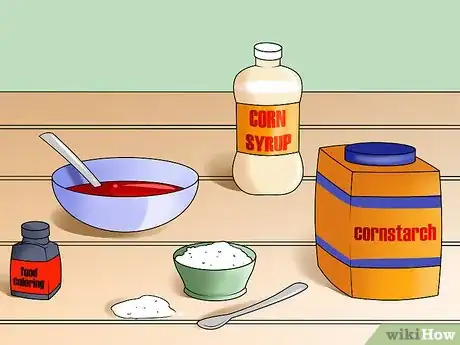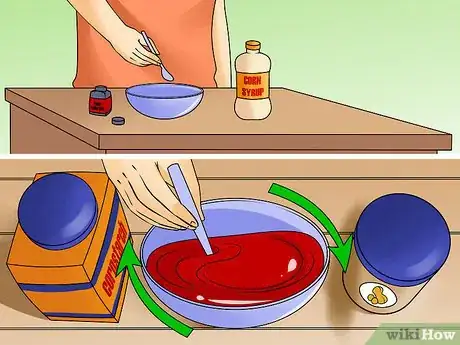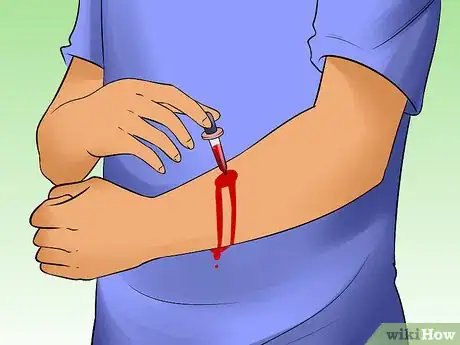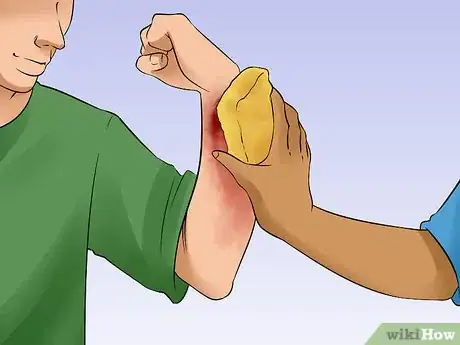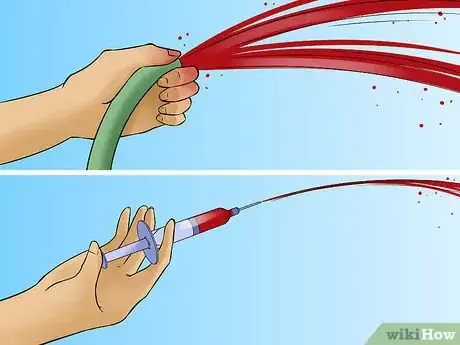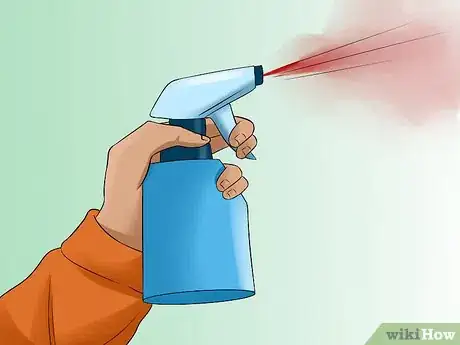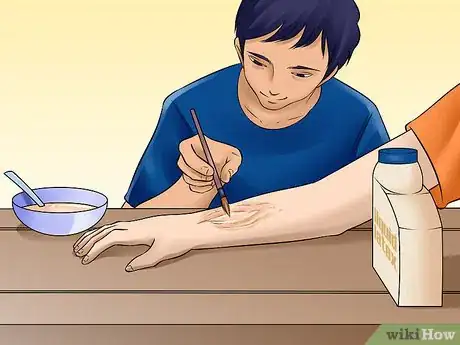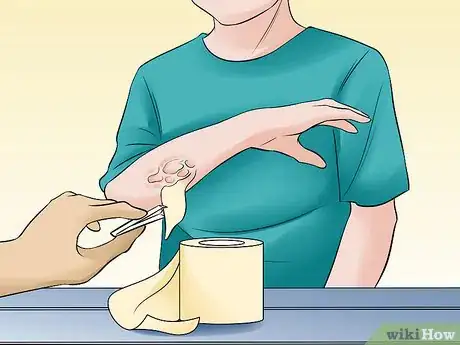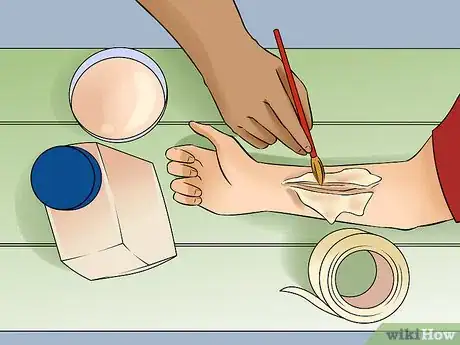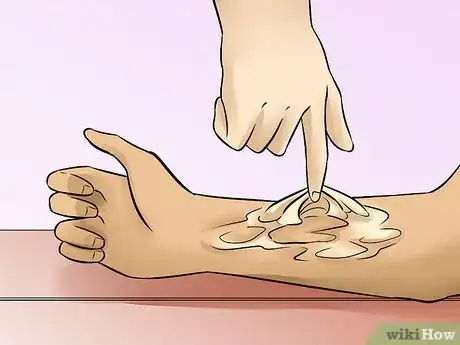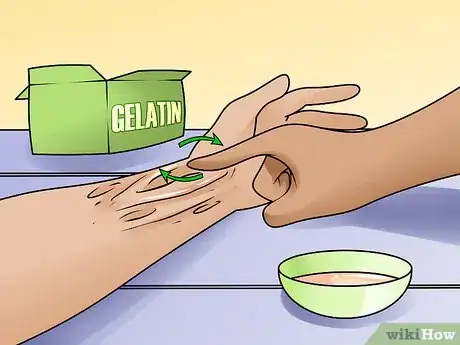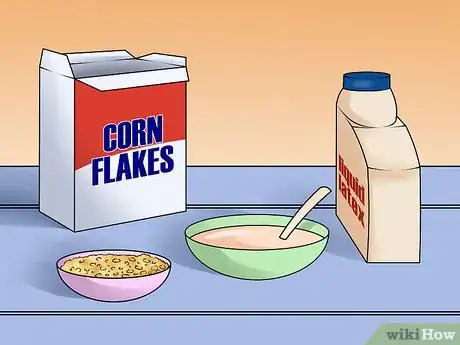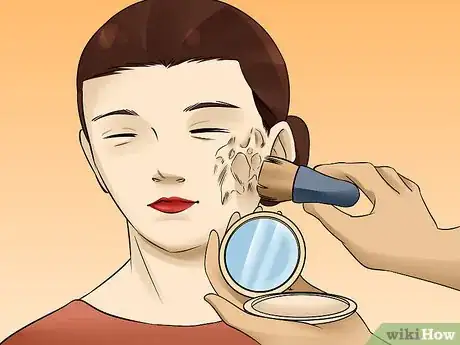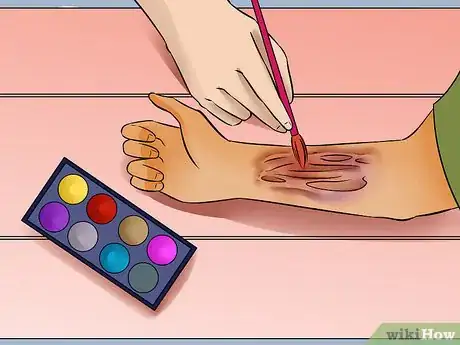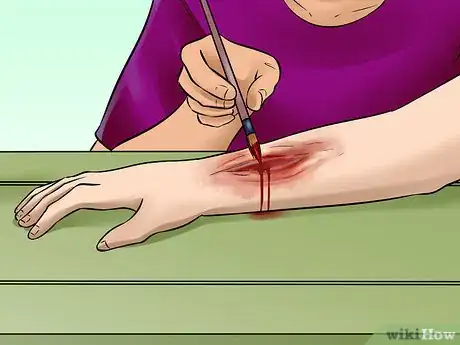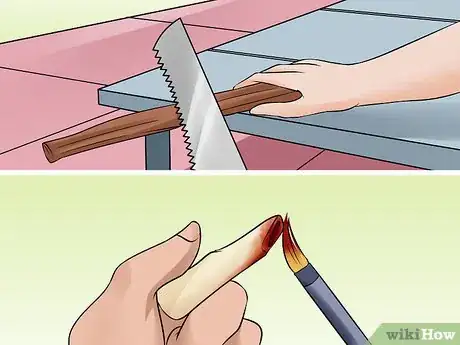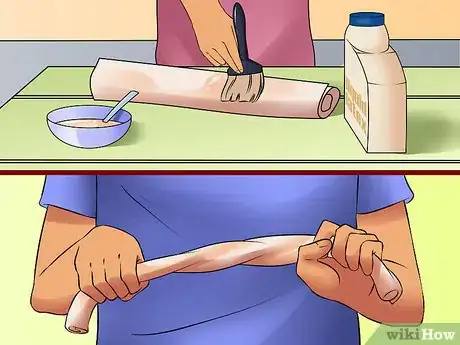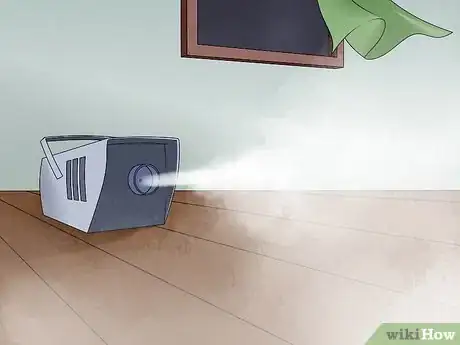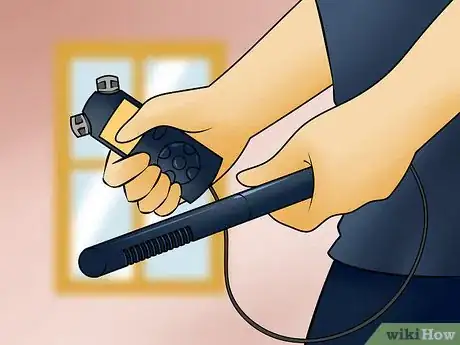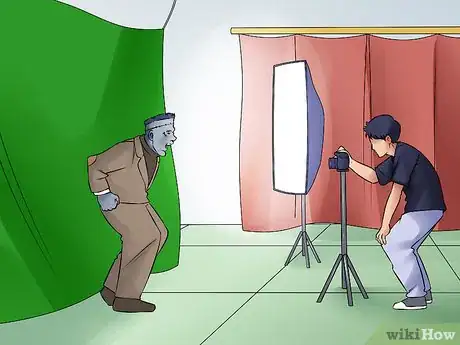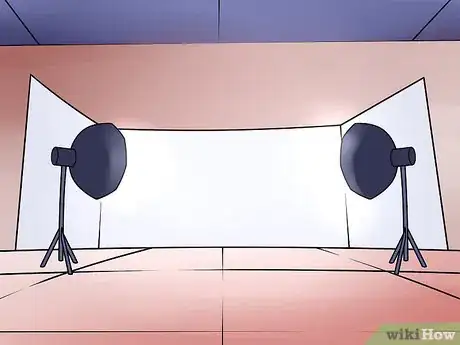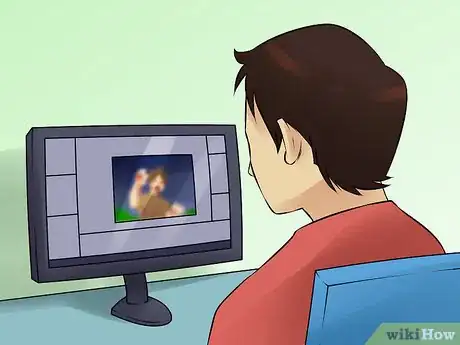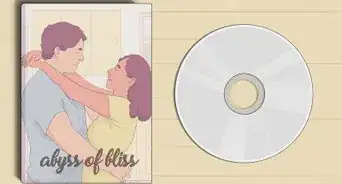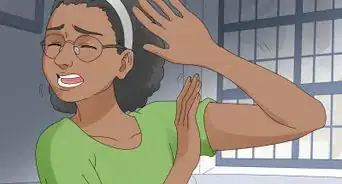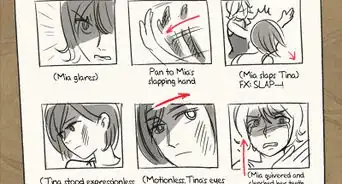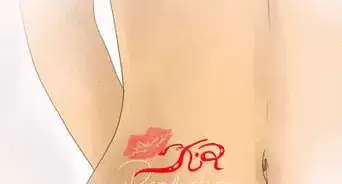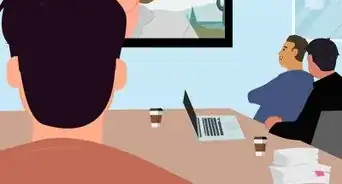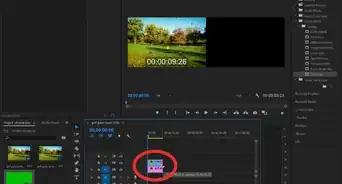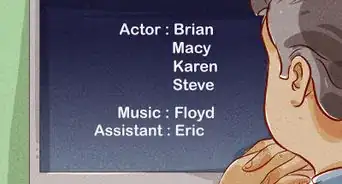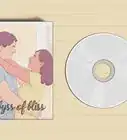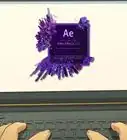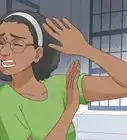This article was co-authored by Joseph Harwood and by wikiHow staff writer, Hunter Rising. Joseph (JoJo) Harwood is a Beauty, DEI & Social Media Expert, Artist, CEO of Joseph Hartwood Ltd, and Creative Director of Team Baron Group. With over 15 years of experience, they specialize in all aspects of beauty, digital media production, and supporting diversity and inclusion efforts in businesses. JoJo has pioneered YouTube content and branding, with over 100 million views on their YouTube tutorial content and was the first and only winner of Simon Cowell's You Generation Competition. They studied an MSc in Cosmetic Science from the London College of Fashion, combining a technical understanding of cosmetics with beauty expertise.
There are 20 references cited in this article, which can be found at the bottom of the page.
This article has been viewed 131,157 times.
If you’re making a horror movie, special effects can help make any blood and gore feel more realistic. Luckily, you can make many practical effects at home using common ingredients and supplies. Use fake blood and apply artificial wounds to make your characters look creepier on camera. If you need more details, like bones or guts, you can make and incorporate those as well! When you finish your effects, your horror film will look scary and authentic!
Steps
Mixing and Applying Fake Blood
-
1Combine corn syrup, food coloring, and cornstarch to make realistic blood. Mix together 2 cups (470 ml) of corn syrup and 1 cup (240 ml) of warm water in a large mixing bowl. Pour in 10 teaspoons (49 ml) of red food coloring and a few drops each of blue and yellow coloring.
Stir in 1 tablespoon (7.5 g) of cornstarch at a time until it’s thoroughly mixed, and keep adding it until there are 10 tablespoons (75 g) in your mixture. This style of fake blood is somewhat sticky so it will stay in place when you apply it, but it won’t run as easily.[1]
Try adding cocoa powder if you want your fake blood to look darker. Use less cornstarch if you want the fake blood to flow easier.- This recipe is edible so you can apply it in or around someone's mouth.
-
2Use creamy peanut butter and corn syrup to make things look bloodstained. Pour 10 teaspoons (49 ml) of red food coloring and 1 cup (240 ml) of light corn syrup in a mixing bowl. Combine the corn syrup with 1-2 heading spoonfuls of creamy peanut butter and stir the mixture together until it’s thoroughly mixed.
Apply the fake blood by hand and rub it on a surface to make it look like it’s coated in a thin layer of blood. If you want to make the blood look like it’s dried up or scab-like, try using chunky peanut butter instead.[2]
Keep in mind that it may be harder to work with and apply. This fake blood is edible so it's safe to use near someone's mouth.Advertisement -
3Apply the fake blood with a syringe or dropper to make it seem authentic. Pour your fake blood mixture into small syringe or dropper bottle so you can easily apply it. Squeeze the bottle or depress the syringe slightly so a small amount of blood comes out.
Let the fake blood drip down the surface you’re applying it to so it looks realistic when it’s on camera.[3]
Be careful not to get the fake blood in anyone’s eyes since it could cause irritation. You can apply fake blood in and around a person’s mouth if you need to as long as you’re using an edible recipe.Warning: Fake blood could stain carpets or fabrics. Test the fake blood on an inconspicuous spot and try cleaning it up to see if it leaves any marks.
-
4Smear the fake blood with a sponge or scouring pad. Dip the corner of a scouring pad or sponge in your fake blood and dab it onto the surface you’re applying it to.
You can either lift and dab the blood to apply it in a pattern or you can wipe the blood across a surface to make smears. Try a few different techniques on the surface to see what works best when you apply it.[4]
Test different applicators to see what textures they make with the fake blood. For example, a steel wool pad will cause the blood to bead up while wiping it with a sponge will look flatter. -
5Make blood squirt using plastic tubing and a syringe. Attach a syringe to the end of a thin plastic tube and fill the syringe with your fake blood. Put the other end of the tube next to where you want the blood to spray so it’s off camera, and tape it in place.
During your shot, have a person off-camera press down on the syringe slowly so the blood squirts out of the tube.[5]
This method works great to simulate blood squirting out of a pulsing wound. This may not work if your fake blood has a thicker consistency. -
6Create blood spatter with a spray bottle. Pour your fake blood into an empty spray bottle and make sure the nozzle is on. Pull the handle on your spray bottle to create a mist of blood that spatters on the surface you’re applying it to.
Apply as much or as little fake blood with the spray bottle as you need to for the scene you’re shooting.You won’t be able to spray fake blood that has a thick consistency.[6]
Making Artificial Wounds
-
1Paint a layer of liquid latex where you want to place the wound. Dip the end of a paintbrush into the liquid latex and paint it onto your actor’s skin. Apply the latex in a shape that looks like a natural wound so it doesn’t appear fake on camera.
Spread the latex thin enough over the surface so you can barely see the skin underneath it.[7]
You can buy liquid latex at costume stores or online. If you or someone on your film has a latex allergy, you can use white school glue instead though it may not hold as well. -
2Put a piece of toilet paper on the latex and rip it into the shape of the wound. Lay a piece of toilet paper over the surface of the liquid latex. Press the toilet paper so it’s flat against the skin without any bubbles or deformation.
Once the toilet paper is applied, carefully tear the edges of the toilet paper by hand so it matches the shape of the latex you applied.[8]- You can also use tissues if you don’t have any toilet paper.
-
3Brush latex over the toilet paper and let it dry. Dip your paintbrush back in the liquid latex and paint around the edges of the paper you applied so they don’t lift off of the skin. Then carefully paint over the surface of the toilet paper so the wound looks shiny and fresh. Let the latex dry completely, which should only take about 5-10 minutes.[9]
- Use a hair dryer if you want to make the liquid latex dry faster.
Tip: You can add more layers of toilet paper on top of the first one if you want to make the wound look deeper. Use smaller pieces of toilet paper each time so the wound is thickest in the center.
-
4Rip the center of the toilet paper to make the wound three-dimensional. Once the latex is dry, use your fingernail or pin to tear through the center of the toilet paper.
Pull the edges of the tear to the side to bunch the toilet paper up to make your wound look like it’s deep and sticking out of the skin. Keep working with the edges of the tear until you’re happy with the shape.[10]
Be careful not to accidentally stab the person you’re applying the wound to if you’re using a pin or sharp object to tear the paper.
If you don’t know what you want your wound to look like, then look up images from other horror movies or actual wounds to get ideas for reference. -
5Apply lumps of gelatin around the wound if you want it to look like a burn. Follow the mixing directions on a package of gelatin and stir it until it has a syrupy consistency. Use a brush or a butter knife to apply the gelatin in thick lumps around the fake wound.
Stretch the gelatin and move it around randomly to shape it. The gelatin will quickly set and dry in place.[11]
Test the temperature of the gelatin on your hand before applying it since it could be hot when you mix it. -
6Use oatmeal or corn flakes to add more texture to wounds. When you’re applying wounds, crush up some oatmeal or corn flakes and attach them with liquid latex. Let the latex dry completely before painting over the oatmeal to make it look like a wound. The oatmeal or corn flakes will give the wound a bumpier texture and make it seem more realistic.[12]
-
7Blend the wound into your skin tone with foundation. Use a powder or cream foundation that matches the skin tone of your actor and apply it over the entire wound as a base coat.
Make sure none of the toilet paper shows through the foundation or your wound will look fake. Blend the edges of the wound into the skin with a blending sponge so it looks realistic.[13]
A foundation airbrush will give your fake wound the smoothest application, but any applicator will work for painting your wound. -
8Paint or brush colored makeup onto the wound to make it look realistic. Use a makeup brush to add in different shades of blue, brown, purple and black around the edges of your wound. Work from the lightest to the darkest colors so they’re easier to blend. Keep painting the wound until you’re satisfied with how it looks.[14]
- You can buy makeup kits with color palettes meant for wounds from a costume shop or online.
- Look up pictures of the actual wound you’re trying to create so it looks authentic. Be aware that you may see some graphic images during your search.
- If you aren’t getting a close-up shot of the wound on camera, then you don’t need to spend time making a lot of details while you’re applying the makeup.
-
9Apply fake blood inside and around the wound so it seems fresh. Take some of the fake blood you’ve made and paint it on the inside of the wound so it looks it’s bleeding. Apply a thick layer of the blood on the inside of the wound so it appears wet and fresh on camera.
Then, use a sponge to add some blood spatter around the outer edges of the wound so it seems like it’s dripping out.[15]- Test how the wound looks on camera to see if you need to apply more blood.
- If you want blood to look older and dried out, add some brown hues.
Adding Scary Details
-
1Cut and paint wooden dowels to look like broken bones. Pick wooden dowels that are the same thickness as the bone you’re trying to replicate and cut the end at an angle. Use a sander or sandpaper to add deformities and marks to the dowel so it doesn’t look perfectly cylindrical.
Paint the dowels white and paint a small amount of fake blood on the ends so they look the ends of broken bones.[16]
Wrap liquid latex and toilet paper around the sides of the dowel and paint it to look like a bone sticking out from someone’s skin. -
2Roll up paper towels with liquid latex to make fake guts. Paint 2-3 layers of liquid latex on a flat surface. Spin multiple pieces of paper towel together to make long ropes and drag them through the latex carefully so they don’t rip.
The latex will help the paper towel stick to itself and make them look wet. Let the liquid latex dry completely before dipping the paper towel in fake blood to give them a red color to look like guts.[17] Make multiple ropes of various sizes to make the fake guts look more believable.- You can also stuff the paper towel in beige stockings if you want.
-
3Use a fog machine to make the set look eerie. Set up a fog machine in the location where you’re filming your horror movie and run a fog machine so the room it fills the area. Run the fog machine in between takes to make it appear more full. The fog makes your film set look more mysterious and can make your movie scarier.[18]
- Check party supply stores to see if they offer fog machine rentals. Otherwise, you can buy them online.
-
4Record sound effects with common household materials. Many sounds you hear in movies are added later and are made from objects you may have around the house.
Record creaky floors, squeaking doors, and loud footsteps so you can add them to your film if you need to. Experiment with breaking, hitting, or handling a variety of different objects since they may make sounds you could use later on.[19]
For example, you may snap a celery stalk in half to use as the sound of a bone breaking or hit a watermelon with a hammer to simulate hitting someone else.
If you need to record sounds for a creature or monster, try making the noises yourself and adjusting them in audio editing software. -
5Film in front of a green screen so you can add a scary background later. Hang a green screen in front of a wall so you or your actors can stand in front of it. Point the camera at the green screen and record the scene you want to shoot.
When you edit your footage, you can use video editing software to add in a different background so you don’t have to shoot on location.[20]- You can buy green screens online.
- You can also use a plain green sheet as long as it doesn’t have wrinkles in it.
Warning: Don’t let an actor wear the same color as your green screen or else they will also disappear when you edit your footage.
-
6Try lighting your movie from different angles. Test different lighting setups while you film to see what makes your shots look creepier. Put the lights underneath your actors or monsters to make them look more sinister.
Have your actor stand in front of a light to cast an ominous shadow on set. Try the same shot with your different setups so you can have the option to use them later if you want.[21]
Use different light sources for your scenes. If a character is exploring in the dark, use the light of a flashlight to make your scene look scarier. -
7Add color and animated effects with digital software. Download software like Adobe After Effects or Blender to add additional effects once you’re finished filming.
You can try making 3D models and animating them if you need to make a creature or effect you couldn’t do practically. Adjust the color filters to blue or green for a classic horror effect and to make your movie feel creepier.- You may need to pay for advanced editing software.
- Look for video tutorials for the effect you’re trying to achieve to find detailed explanations of the process.
Expert Q&A
-
QuestionHow do you get liquid latex off of clothes?
 Joseph HarwoodJoseph (JoJo) Harwood is a Beauty, DEI & Social Media Expert, Artist, CEO of Joseph Hartwood Ltd, and Creative Director of Team Baron Group. With over 15 years of experience, they specialize in all aspects of beauty, digital media production, and supporting diversity and inclusion efforts in businesses. JoJo has pioneered YouTube content and branding, with over 100 million views on their YouTube tutorial content and was the first and only winner of Simon Cowell's You Generation Competition. They studied an MSc in Cosmetic Science from the London College of Fashion, combining a technical understanding of cosmetics with beauty expertise.
Joseph HarwoodJoseph (JoJo) Harwood is a Beauty, DEI & Social Media Expert, Artist, CEO of Joseph Hartwood Ltd, and Creative Director of Team Baron Group. With over 15 years of experience, they specialize in all aspects of beauty, digital media production, and supporting diversity and inclusion efforts in businesses. JoJo has pioneered YouTube content and branding, with over 100 million views on their YouTube tutorial content and was the first and only winner of Simon Cowell's You Generation Competition. They studied an MSc in Cosmetic Science from the London College of Fashion, combining a technical understanding of cosmetics with beauty expertise.
Beauty, DEI & Social Media Expert Liquid latex bonds with cloths and can be difficult to remove without a commercial solvent. Wear an apron or clothes you don't mind getting ruined when you work with liquid latex.
Liquid latex bonds with cloths and can be difficult to remove without a commercial solvent. Wear an apron or clothes you don't mind getting ruined when you work with liquid latex.
Warnings
- Your fake blood could stain fabric and carpet. Test out the fake blood you’re using to see if it causes any stains or if it can easily be removed.⧼thumbs_response⧽
Things You’ll Need
Mixing and Applying Fake Blood
- Measuring cups
- Mixing bowl
- Corn syrup
- Red, blue, and yellow food coloring
- Cornstarch
- Creamy peanut butter
- Syringe or dropper
- Plastic tubing
- Sponge or scouring pad
- Spray bottle
Making Artificial Wounds
- Liquid latex
- Toilet paper
- Plain gelatin
- Foundation
- Makeup
Adding Gruesome Details
- Wooden dowels
- Sandpaper
- Paper towels
- Liquid latex
- Oatmeal or corn flakes
References
- ↑ https://youtu.be/RhuR1VMkpXM?t=32
- ↑ https://youtu.be/TEj86v5jWyA?t=397
- ↑ https://youtu.be/_AFgTO09tIY?t=33
- ↑ https://youtu.be/UPLsTjv1yx8?t=4
- ↑ https://youtu.be/YohIMCwb9g8?t=82
- ↑ https://nofilmschool.com/2016/08/how-create-convincing-practical-effects-your-indie-gore
- ↑ https://youtu.be/LyQbgkmPQ74?t=158
- ↑ https://youtu.be/LyQbgkmPQ74?t=165
- ↑ https://youtu.be/LyQbgkmPQ74?t=187
- ↑ https://youtu.be/LyQbgkmPQ74?t=247
- ↑ https://youtu.be/tsU90V2Fmmc?t=29
- ↑ https://www.popularmechanics.com/culture/movies/a9572/diy-blood-and-guts-for-a-gruesome-halloween-16082910/
- ↑ https://youtu.be/LyQbgkmPQ74?t=315
- ↑ https://youtu.be/LyQbgkmPQ74?t=330
- ↑ https://youtu.be/LyQbgkmPQ74?t=353
- ↑ https://youtu.be/7Kw_O4oAJ00?t=147
- ↑ https://www.popularmechanics.com/culture/movies/a9572/diy-blood-and-guts-for-a-gruesome-halloween-16082910/
- ↑ https://www.premiumbeat.com/blog/cinematography-tips-for-horror-filmmakers/
- ↑ https://youtu.be/zrcpfwIkcoM?t=60
- ↑ https://youtu.be/oxjlKc8ms1c?t=54
- ↑ https://nofilmschool.com/2016/10/8-spooky-lighting-techniques-you-can-use-your-horror-film
